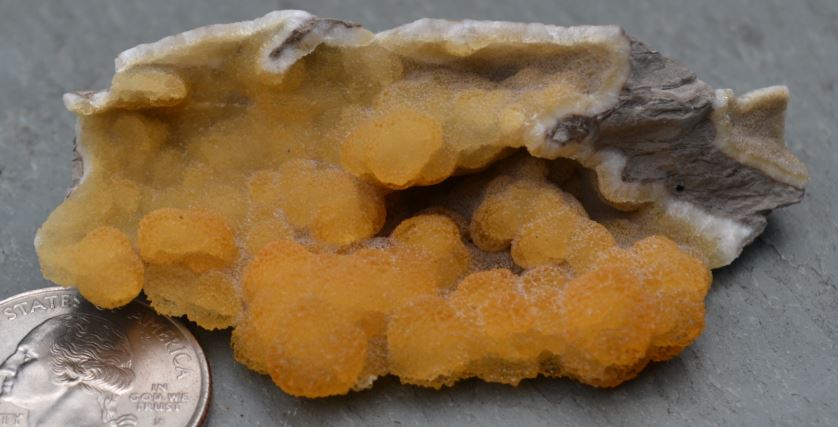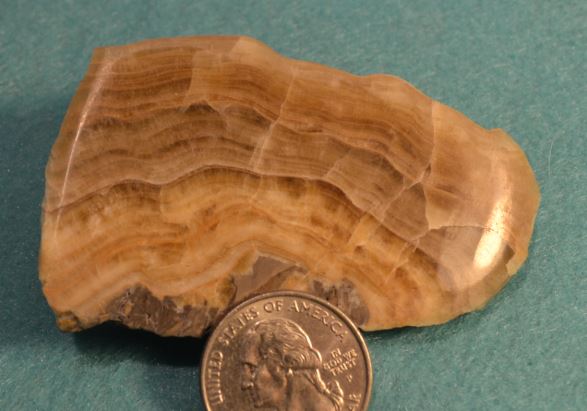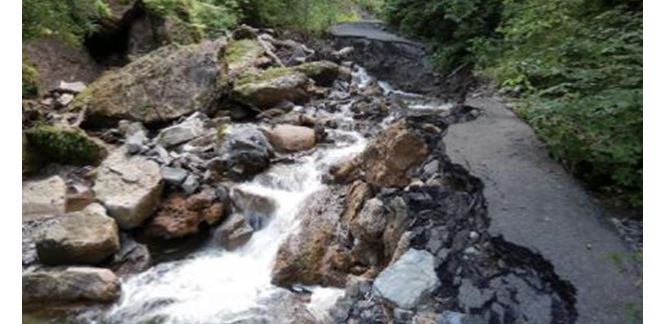Cold Water Travertine at Ilion
Some 30 years ago, Herkimer County decided that the annual flooding and requisite road repair on Jerusalem Road (Co. Rd 16) south of Ilion was not worth the cost and effort and a one mile section of the road was permanently closed. In the 30 years hence, the road has been washed out repeatedly and is now a mere paved path in the woods. In fact, there is not much left of the old road (note the asphalt along the right side of the cover photo).
About half way along this section of road there is a series of springs which exit the shale that is exposed in the gully. At this point fractures in the shale have been partially filled and coated with travertine (a form of calcite). Varying in color from yellow to orange to various shades of brown this material has become a favorite of local collectors. Our club has generally scheduled an annual trip to this location. This year nine of us visited on June 24th and were not disappointed.
Although calcite crystals are not available, collectors can focus on recovering colorful botryoidal specimens that grew in fractures with sufficient open space to produce the attractive geometry. Or one can look for highly banded more massive travertine that can be polished or slabbed. This form of travertine is often termed flowstone. Occasionally, or maybe rarely, one can find stalactites where the travertine must have grown on the roof of an opening, perhaps caused by the collapse and removal of shale below.
 Botryoidal orange travertine from Ilion Gorge .
Botryoidal orange travertine from Ilion Gorge .
 Banded travertine from Ilion Gorge polishes nicely.
Banded travertine from Ilion Gorge polishes nicely.
Generally, we think of travertine as a product of thermal spring activity such as Mammoth Hot Springs in Yellowstone or the deposits in Hot Springs, Arkansas. However travertine can form in low temperature environments also. At Ilion, the ridges along both the north and south side of the gorge are capped by limestone while the gorge has cut into the underlying shale. Carbon dioxide-laden rain water slowly dissolves the limestone along underground cracks and fissures. When it enters the underlying shale, the ground water is now fully saturated with calcium carbonate and carries elevated dissolved carbon dioxide gas. When this water emerges in springs along the gorge walls the carbon dioxide is rapidly released to the atmosphere resulting in a sudden and dramatic increase in pH. With pH increasing calcium carbonate (calcite) is no longer soluble and travertine is precipitated.
Often this travertine is mixed with algal material or inorganic ions such as iron yielding colorful layering (see photo on previous page). Banding or layering in the travertine can reflect seasonal changes in the chemistry of the spring water or the surface conditions when the travertine formed. Slabbed travertine from this material can be particularly pretty.
Given the constantly wet nature of a spring filled gorge, moss lines the gully walls in many places. This creates another interesting geologic condition. When the carbon dioxide release from emanating spring water occurs in a moss laden region of the gorge, the moss can be calcified, preserving the actual texture of the plant itself.
 Calcified moss from Ilion Gorge.
Calcified moss from Ilion Gorge.
In places, the moss along a significant section of the south facing gorge wall just west of the main travertine site seems to have been fully calcified. Often, fresh moss is growing directly atop a calcified moss base creating a very interesting and dynamic interplay between biology and geology.
References:
Chamberlain, S. C., and Robinson, G. W., 2013, The Collector’s Guide to the Minerals of New York State, Schiffer Publ., p. 33-35.
Walter, M.,2004, Travertine from Ilion Gorge, New York, Rock and Gem November issue

when looking for the calcite in the Ilion gorge what should one keep there eye out for? I will be going up there soon to have a look around and wonder what is the best way of going about it.
just walk up the creek about 1500′ until you see large boulders and a collapsed section of road. The travertine is strewn throughout the material in the creek. Be very careful approaching the ledges on the south side of the creek where you can see it in outcrop. They look very unstable and likely to collapse if disturbed. Settle for the material and near creek level